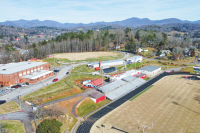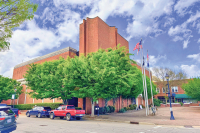Specialty license plates rescued
 Colorful specialty license plates have been spared the gallows thanks to a bill passed in the final hours of the General Assembly last week.
Colorful specialty license plates have been spared the gallows thanks to a bill passed in the final hours of the General Assembly last week.
License plates embellished with a Smokies black bear, the scenic Blue Ridge Parkway, an Appalachian Trial hiker, a stately elk — and a few dozen others — were going to be stripped from bumpers in 2015. They would have been replaced with a far duller version sporting a small, simple logo relegated to one corner.
But two years of lobbying and campaigning to save the plates finally paid off. The General Assembly passed a bill to save the specialty license plates, undoing previous legislation that called for their demise.
Convincing legislators to go to bat for the specialty plates wasn’t easy in such a volatile state political climate.
“Quite frankly, there were some huge issues going on in Raleigh. It made it extremely difficult. No one wanted to expend their political capital,” said Holly Demuth with the Friends of the Great Smoky Mountains National Park in Waynesville.
Related Items
The specialty plates are a money maker for myriad causes behind the veil of the eye-catching images. Motorists cough up a surcharge for the specialty plates, raising $15 to $30 a pop for their respective organization.
For Friends of the Smokies, the iconic black bear license plate brings in $400,000 a year to support special projects on the North Carolina side of the park, from field trips for school children to the construction of a new visitor center.
If the plate lost its aesthetic appeal, “We anticipated a dramatic drop,” Demuth said.
For many motorists, however, losing the pretty license plates would simply make life a little less fun.
David Smith of Waynesville has proudly sported a few different license plates during the years — from Friends of the Smokies to Confederate Veterans to Rocky Mountain Elk Foundation. His latest bumper attire, though, is a person canoeing down a tree-studded river in the name of N.C. State Parks.
Smith likes the scene, and the cause.
“It goes to the park service,” Smith said. Hopefully, the extra money he pays for the plate will help keep overlooks along the Blue Ridge Parkway cleared, he added.
For the record, the Parkway is a national park — so it doesn’t benefit from Smith’s state park plate.
But hey, a pretty picture and noble cause are reason enough to buy a plate — even if the exact cause is lost in the details.
“Yeah, it’s the picture,” Smith said of how he chooses his plates. “The picture means more than anything.”
And that’s why so many thought the full color plates were worth fighting for. A survey by the Blue Ridge Parkway Foundation found that 80 percent of those with Parkway plates got them because they liked the way they looked.
Replace the pretty design with a basic logo and sales were sure to drop.
For Smith, his various license plates are a way to display a little home state pride in his line of work as a traveling industrial boiler mechanic. The toolbox on his truck is plastered with dozens of stickers — layer on layer — from jobs he’s done all over the country. But it’s the license plate on his bumper that allows him to take a little slice of home on the road.
“It kind of says a statement about where I live,” said Smith.
As Smith emerged from the license plate office in Waynesville this week, he was getting itchy for a new look. He fancies the license plate with a lighthouse and coastal scene — which supports Ducks Unlimited — and might trade in his canoeist for an ocean theme next go-around.
“I like the ones with water,” Smith said.
Friends of the Smokies and the Blue Ridge Parkway Foundation orchestrated the most visible campaign to save the plates during the past two years. They worked legislators directly but also sounded the alarm within the ranks of their own membership, asking supporters to call and write their representatives.
They paid for “Save the Plates” billboards and even hired a lobbyist.
“We have been using many different avenues and approaches,” Demuth said.
Sen. Ralph Hise, R-Burnsville, said the money raised from the specialty plates is helpful to the whole region. The Parkway and Smokies plates alone have raised $6 million since their creation to fund special projects and initiatives in the two parks.
“They help promote the area and help build travel and tourism,” Hise said.
N.C. Rep. Joe Sam Queen, D-Waynesville, said the last-minute bill saving specialty plates was a “a ray of sunshine in otherwise a cloudy legislative year.”
Queen fought for the legislation not only to save existing full-color plates but also because he wanted to pave the way for a new plate for the “brookie,” the Southern Appalachian native brook trout. The money raised by the new plate will go to the N.C. Wildlife Commission for brook trout restoration.
He called it a win-win for WNC, citing the $200 million economic impact of trout fishing in the mountains.
“Trout fishing enthusiasts can now have a tag with our own native speckled brook trout,” Queen said. “It will support trout fishing and clean waters and all the things that go with it in Western North Carolina.”
A crowded field
The list of causes with a specialty plate is a long one, some 200 in fact, and growing all the time.
New to the game this year are the N.C. Bluegrass Association, the N.C. Cattlemen’s Association, Pancreatic Cancer Awareness, the Sea Turtle Rescue Team, the Sneed’s Ferry Shrimp Festival, a youth golfing organization, Mission Hospital Foundation, the brook trout, Charlotte’s minor league hockey team and the Asheville-based environmental organization River Link — just to name a few.
Demuth has become an expert on specialty plate legislation during the past two years as she tracked the fate of the plates in the General Assembly. She regularly listened in legislative committee meetings via live audio stream from her Waynesville office whenever specialty plates appeared on the discussion docket. She recalled a joke by the chairman of the N.C. House Transportation Committee during one of the many hearings.
“He said, ‘For all you freshmen legislators, this is our annual license plate bill. If we haven’t captured every cause or organization in your district, don’t worry. Next year, we will get those two that are left,’” Demuth recounted.
Demuth isn’t worried about the competition these newcomers on the scene potentially pose, however.
“Full color plates represent only 1 percent of all North Carolina plates. So there is plenty of room before we hit market saturation,” Demuth said.
The rampant number of specialty plates likely helped on the political front. There are so many, from every corner of the state, that just about every legislator would have had constituents back home angry over the prospect of full-color plates being axed.
How it started
Legibility was proffered as the reason for axing the specialty plates in 2011. Full-plate designs made the numbers hard to read, according to legislators wanting to phase out the plates.
So Friends of the Smokies and the Parkway Foundation brokered a compromise: a white rectangular background behind the numbers and letters but the overall image on the plate remaining intact.
In the meantime, the N.C. Division of Motor Vehicles and N.C. Highway Patrol did their own assessment of the specialty plates. They deemed the plates easily legible by cops and toll booth cameras with the addition of a white background behind the numbers.
“They both recommended the specialty plate program be continued,” Demuth said. “That was huge, to have the safety of the plates confirmed by those on the ground that actually deal with the plates. For them to say it was not an issue was a turning point.”
Going forward, full-color plates must have the white background behind the numbers. But anyone with an existing full-color plate can keep it rather than trading it back in.
It’s unclear just how real the safety argument ever was, however. One widely circulated explanation in political circles blamed the near demise of specialty plates on little more than sour grapes.
A few legislators had unsuccessfully tried to pioneer a Choose Life anti-abortion license plate. When they couldn’t get it through, they decided to kill the plates for everyone.
Incidentally, a Choose Life plate has since been approved by state legislators — it’s full color — but it quickly ran into legal challenges over inappropriate political overtones and it remains hung up in court.
Not all the state’s specialty license plates rise to the level of full-color designs. There’s some 200 specialty plates, and only around 40 of them have full-plate designs. The rest sport only a tiny logo or thumbnail image in a corner of the plate.
The latest specialty plate bill not only saved existing full-color plates but paved the way for their proliferation.
Those who previously only had small logos may see doors open now.
The Friends of the Mountains to Sea Trail, for example, is hoping to upgrade from a small logo to a full-color plate under the new legislation.
Before the state will manufacture a specialty plate, there must be at least 300 orders. But now under the latest license plate legislation, a group that hits 500 plate orders can upgrade to a full color plate.









